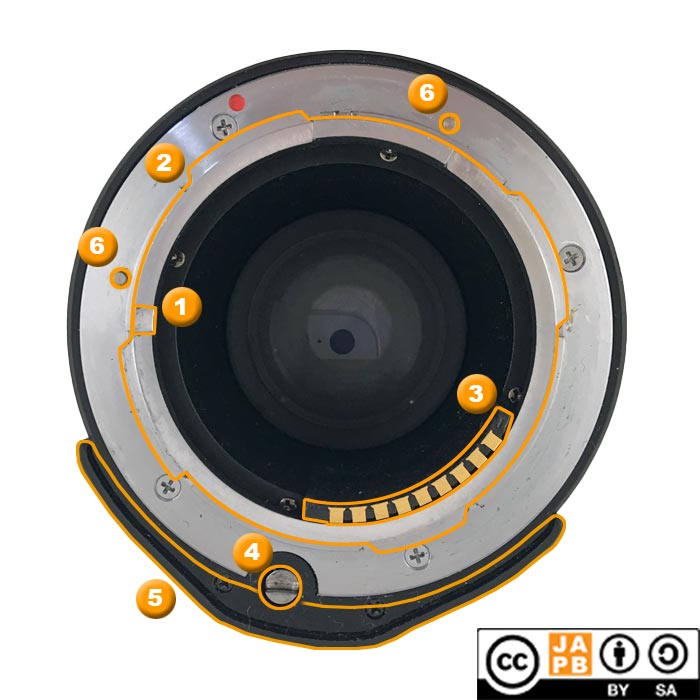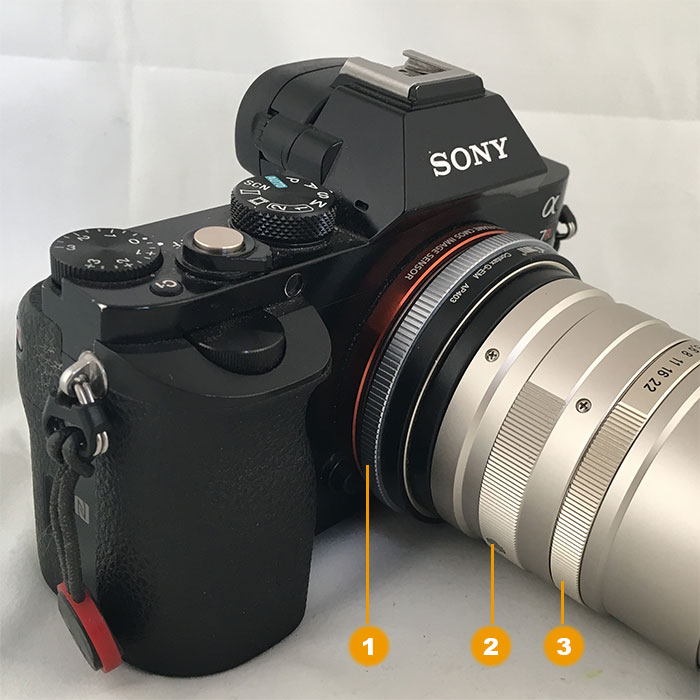Pekka Buttler, May 2020 (Updated May 2025)
Contax G mount specifications
Mount type: Combination of bayonet and breech-lock1.
Flange focal distance: 29 mm
Film format: 36mm x 24mm (‘Full frame’)
Mount communication: Electronic contacts for communicating aperture and lens ID; slot-drive screw for driving autofocus.
Identifying the Contax G mount

Key characteristics of the Contax G -mount:
[1] Locking notch at 3 o’clock (but, unusually, on the rearwards facing end of the “bayonet”, not on the flange and not on a bayonet prong)
[2] Bayonet-like construction with four prongs
[3] Bank of electronic contacts
[4] Slot-drive screw
[5] Bulge (housing gearing for slot-drive)
[6] Pins for detecting mounting on camera (or adapter)
Basics of the Contax G -mount
‘Contax’ is undoubtably one of the most legendary names in photography. First used in 1932 for a groundbreaking 35 mm camera made by Zeiss Ikon, during the more recent decades, the name Contax has made several reappearances in photography hardware which (while certainly holding onto something of the original Contax legacy) have been both geographically and administratively quite far removed from the name’s origins. Since the 70’s, the name Contax was first used for SLR’s manufactured in a Zeiss-Yashica (Kyocera) co-operation, and later (1990’s) for the Kyocera-built Contax G autofocus, interchangeable lens rangefinders (as well as a range of compact cameras).
The main strengths of the Contax G system was the combination of Carl Zeiss rangefinder lenses with a rethinking of what the rangefinder camera could be at the end of the millennium and beautifully executed. The resulting Contax G1 (1994) and G2 (1996) cameras, aimed to combine autofocus and modern metering with the appeal of the rangefinder camera.
Having never actually shot a roll of film with one, I do not want to venture a judgment on how they faired. Suffice it to say that Contax G cameras and lenses continue to fetch high prices in the secondhand market.
But the Zeiss-designed lenses (see short table below) obviously have been a big part of whatever appeal the system had and still has. Problematically, due to their design (mount, flange focal distance, etc.), re-use of these lenses on other systems has been a challenge, until the advent of mirrorless interchangeable lens cameras.
| Design | Focal length | Aperture range | Angle of view | Released | Elements /Groups | MFD | Filter | Weight |
| Hologon | 16 | f/8 (fixed) | 106° | 1994 | 5/3 | 0,3m | –– | 120 g |
| Biogon | 21 | f/2.8–22 | 90° | 1996 | 9/7 | 0,5m | 55mm | 200 g |
| Biogon | 28 | f/2.8–22 | 74° | 1994 | 7/5 | 0,5m | 46mm | 150 g |
| Planar | 35 | f/2.0–16 | 64° | 1994 | 7/5 | 0,5m | 46mm | 160 g |
| Planar | 45 | f/2.0–16 | 50° | 1994 | 6/4 | 0,5m | 46mm | 190 g |
| Sonnar | 90 | f/2.8–22 | 27° | 1994 | 5/4 | 1,0m | 46mm | 240 g |
| Vario-Sonnar | 35-70 | f/3.5≈5.6–22 | 62°–35° | 2000 | 13/8 | 1,0m | 46mm | 290 g |
Adapting Contax G lenses:
Thanks to their shortish flange focal distance (29 mm) and their relatively complex mount, Contax G lenses have not been reusable on other systems until the advent of mILC’s. Another point against their adaptability has been that Contax G lenses – while having a manually controlled aperture – have no focusing ring. With Contax G lenses being body-driven AF lenses, this is not unheard of (while certainly somewhat unusual).
In practice this means that for Contax G lenses to be usable, the adapter has to be able to drive the slot-drive focus screw – either by converting manual-driven focusing into rotations of the slot-drive screw or by containing a small AF motor. Both arrangements exist and are certainly workable, but do demand some millimetres to play with.
I’ve only managed to gather experience of Contax G lenses with a manual adapter, and my take is that, while (as said) workable, the arrangement is far from optimal. Given, that the ring used to drive the slot-driven AF is by necessity very close to the camera body, the arrangement is ergonomically dismal (see pic below). If you’re in the lucky position to own more than one Contax G lens, I’d heartily recommend an adapter which makes the AF function as it should.

[1] Manual focusing ring (drives slot-drive screw)
[2] Breeck-lock locking ring
[3] Aperture ring (full clicks only)
Footnotes
- While technically a breech-lock mount (you insert the lens straight into the camera, then twist a ring on the lens to mount it securely), the Contax G mount evidences a great many bayonet-like features. Not only does it seem to have what looks like an obvious four pronged bayonet construction, it also has a locking notch (although whether it should be classed as a locking notch or locking groove is debatable), which also is a typical bayonet trait. In one sense, the Contax G mount has it all (except for threads). ↩︎